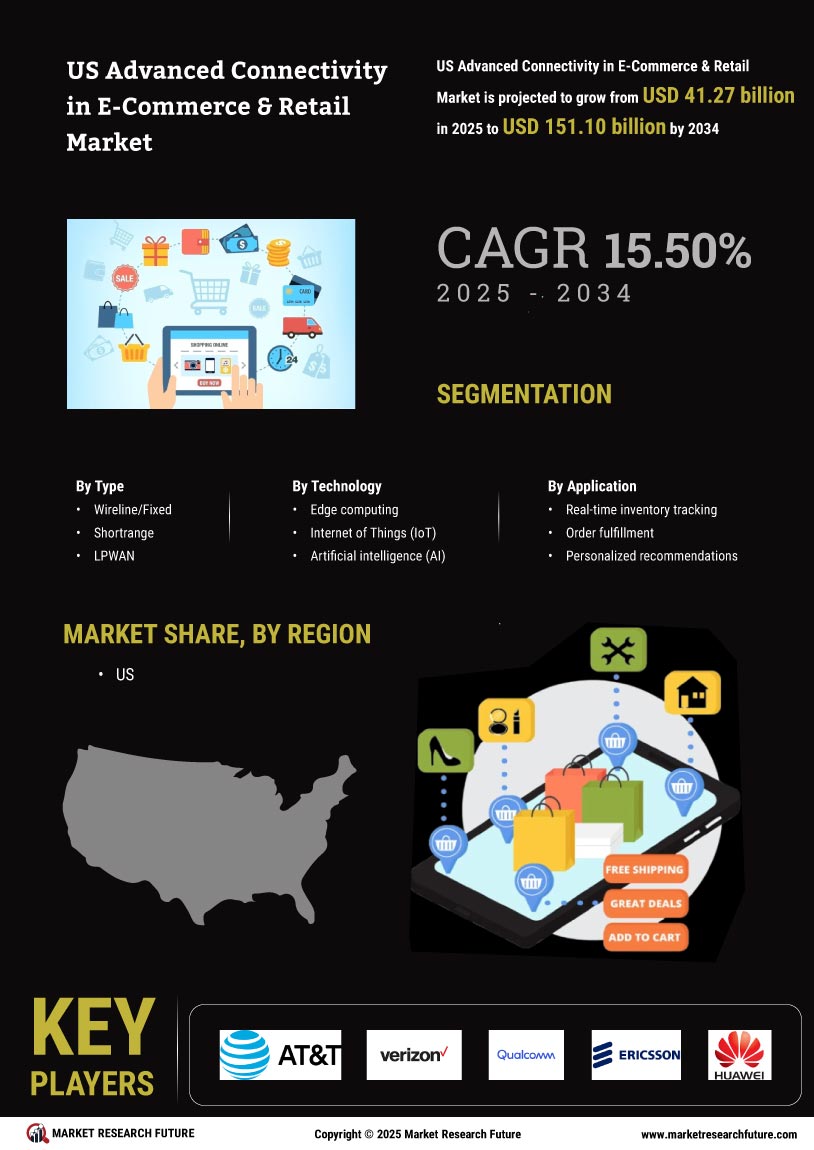Rise of Mobile Commerce
The US Advanced Connectivity in E-Commerce & Retail Market is witnessing a notable rise in mobile commerce, driven by the proliferation of smartphones and mobile applications. As of 2025, mobile commerce accounts for over 50% of total e-commerce sales in the United States, reflecting a significant shift in consumer behavior. This trend indicates that consumers prefer shopping via mobile devices due to convenience and accessibility. Retailers are increasingly optimizing their platforms for mobile use, ensuring that the shopping experience is smooth and user-friendly. Enhanced connectivity plays a crucial role in this transition, as faster internet speeds and improved mobile networks facilitate quick transactions and real-time updates. Consequently, businesses that prioritize mobile commerce are likely to capture a larger market share, as they cater to the evolving preferences of tech-savvy consumers.
Focus on Customer Experience
The focus on customer experience is increasingly becoming a central tenet of the US Advanced Connectivity in E-Commerce & Retail Market. Retailers are recognizing that a superior customer experience can differentiate them in a crowded marketplace. As of 2025, studies suggest that companies prioritizing customer experience are likely to see a 10-15% increase in customer retention rates. Enhanced connectivity allows retailers to gather and analyze customer feedback in real-time, enabling them to make informed decisions that improve service delivery. Furthermore, personalized shopping experiences, facilitated by data analytics, are becoming the norm, as consumers expect tailored interactions. This emphasis on customer experience not only drives sales but also cultivates brand loyalty, positioning businesses for long-term success in an evolving retail landscape.
Expansion of E-Commerce Platforms
The expansion of e-commerce platforms is a pivotal driver in the US Advanced Connectivity in E-Commerce & Retail Market. As of 2025, the number of e-commerce platforms has increased significantly, with major players continuously enhancing their offerings to attract consumers. This proliferation allows smaller retailers to enter the market, leveraging established platforms to reach a broader audience. Enhanced connectivity facilitates this growth, as improved internet access enables more businesses to establish an online presence. Additionally, the rise of social commerce, where social media platforms integrate shopping features, is reshaping how consumers discover and purchase products. This trend indicates a shift towards a more interconnected retail environment, where consumers can seamlessly transition between browsing and buying, ultimately driving sales and enhancing customer satisfaction.
Integration of Artificial Intelligence
The integration of artificial intelligence (AI) within the US Advanced Connectivity in E-Commerce & Retail Market is transforming how businesses operate and engage with customers. AI technologies enable retailers to analyze vast amounts of data, providing insights into consumer behavior and preferences. As of 2025, it is estimated that over 60% of retailers utilize AI-driven tools for personalized marketing and inventory management. This capability allows businesses to tailor their offerings to individual customers, enhancing the shopping experience and increasing conversion rates. Furthermore, AI-powered chatbots and virtual assistants are becoming commonplace, providing 24/7 customer support and streamlining the purchasing process. The reliance on AI not only improves operational efficiency but also fosters a more engaging and responsive retail environment, positioning companies to thrive in a competitive landscape.
Technological Advancements in Connectivity
The US Advanced Connectivity in E-Commerce & Retail Market is currently experiencing a surge in technological advancements, particularly in high-speed internet and 5G networks. These innovations facilitate seamless online shopping experiences, enabling retailers to enhance customer engagement through real-time interactions. As of 2025, approximately 80% of US households have access to high-speed internet, which significantly boosts e-commerce activities. Enhanced connectivity allows retailers to implement advanced technologies such as augmented reality and virtual reality, which can transform the shopping experience. This technological evolution not only improves operational efficiency but also fosters customer loyalty, as consumers increasingly expect fast and reliable service. The integration of these technologies is likely to redefine the competitive landscape, compelling retailers to adapt swiftly to maintain relevance.


















Leave a Comment